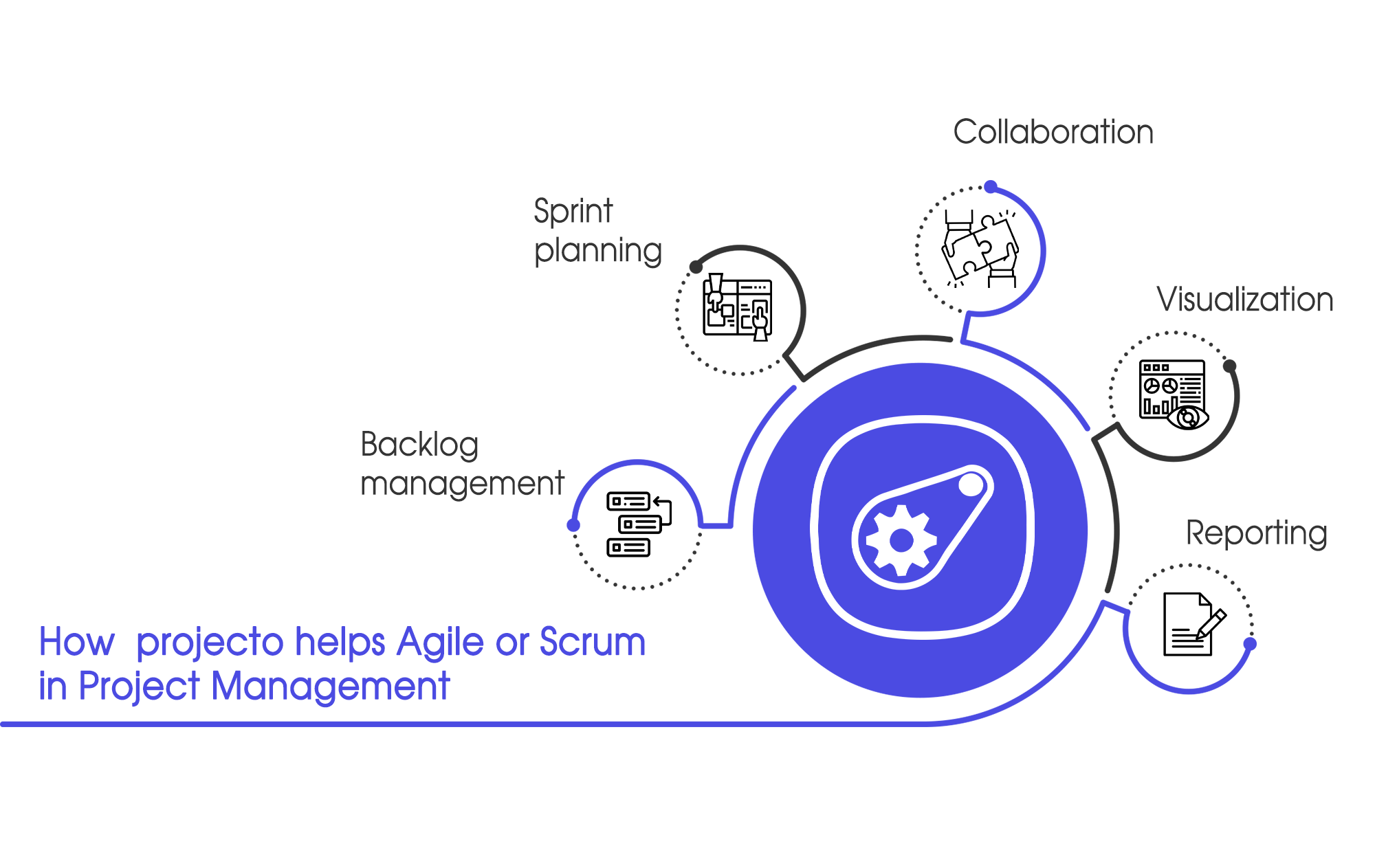
Project management is an essential process for any organization aiming to achieve success in its ventures.
However, traditional project management methodologies are often rigid and time-consuming, leading to delayed completion of projects and decreased productivity.
Agile and Scrum methodologies offer a more flexible and efficient approach to project management, allowing for better collaboration, communication, and adaptation to changing circumstances.
In this article, we will explore how organizations can improve their project management process by adopting Agile or Scrum methodologies. We will discuss the fundamental principles of these methodologies, their benefits, and provide practical tips on how to implement them effectively.
Whether you are a project manager looking to enhance your skills or an organization seeking to increase efficiency and productivity, this article will provide valuable insights into improving your project management process.
II. What is Agile?
Agile is an iterative and flexible approach to software development that emphasizes collaboration, continuous improvement, and delivering value to the customer in small, incremental releases.
Agile is based on a set of principles and values outlined in the Agile Manifesto, which was created by a group of software developers in 2001.
These principles and values are:
Agile Principles:
- Customer satisfaction through early and continuous delivery of valuable software.
- Embrace changing requirements, even if it occurs late in the project timeline.
- Deliver working software frequently, with a preference for shorter timescales.
- Collaborate closely between business people and developers.
- Build projects around motivated individuals and give them the support and environment they need to get the job done.
- Use face-to-face communication as much as possible.
- Working software is the primary measure of progress.
- Sustainable development – able to maintain a consistent pace and work-life balance.
- Continuous attention to technical excellence and good design enhances agility.
- Simplicity – the art of maximizing the amount of work not done – is essential.
- Self-organizing teams that can adapt to change.
- Regularly reflect on and fine-tune the approach to become more effective.
Agile Values:
- Individuals and interactions over processes and tools.
- Working software over comprehensive documentation.
- Customer collaboration over contract negotiation.
- Responding to change over following a plan.
These principles and values prioritize customer satisfaction, collaboration, flexibility, and continuous improvement, which ultimately lead to higher-quality software, faster delivery times, and increased customer satisfaction.
The benefits of Agile:
Agile has numerous benefits for software development projects, including:
- Faster Delivery: Agile enables teams to deliver working software in small, incremental releases, which means that stakeholders can see results sooner and provide feedback. This approach allows teams to be more responsive to changing requirements and deliver value to customers more quickly.
- Increased Flexibility: Agile methodologies are designed to be flexible and adaptable to changing circumstances. Agile teams can adjust their approach as needed to accommodate new requirements or unforeseen challenges, rather than being locked into a rigid plan.
- Greater Customer Satisfaction: By involving customers in the development process and delivering software in small, incremental releases, Agile methodologies ensure that the final product meets customer needs and expectations. This approach leads to greater customer satisfaction and higher rates of repeat business.
- Improved Quality: Agile teams prioritize continuous testing and integration, which means that issues can be identified and resolved early in the development process. This approach results in higher-quality software that is more stable, secure, and reliable.
- Increased Transparency: Agile methodologies emphasize communication and collaboration between team members and stakeholders. This approach fosters greater transparency and accountability, which leads to better decision-making and a more engaged team.
- Better Team Morale: Agile methodologies promote teamwork, trust, and respect among team members. By providing a supportive and collaborative work environment, Agile teams can improve morale and job satisfaction, which ultimately leads to higher productivity and better results.
Overall, Agile methodologies offer numerous benefits for software development projects, including faster delivery, increased flexibility, greater customer satisfaction, improved quality, increased transparency, and better team morale. These benefits help organizations stay competitive, innovate more effectively, and deliver higher-quality software to customers.

III. What is Scrum?
Scrum is a popular Agile framework for software development that emphasizes teamwork, communication, and rapid iteration. It is based on the principles of transparency, inspection, and adaptation.
Scrum has three main roles:
- Product Owner: responsible for defining the product vision and prioritizing the product backlog based on customer feedback and business value.
- Scrum Master: responsible for ensuring that the Scrum process is followed, facilitating meetings, and removing obstacles that impede the team’s progress.
- Development Team: responsible for designing, building, and testing the product increment in a sprint.
Scrum has several events that occur within each sprint:
- Sprint Planning: a meeting in which the team determines the goal of the sprint and selects the items from the product backlog that they will complete.
- Daily Scrum: a short daily meeting in which the team discusses progress, plans for the day and identifies any obstacles that need to be addressed.
- Sprint Review: a meeting in which the team presents the completed work to stakeholders and obtains feedback.
- Sprint Retrospective: a meeting in which the team reflects on the sprint, identifies areas for improvement, and determines ways to implement those improvements.
Scrum has several artifacts:
- Product Backlog: a prioritized list of features and requirements that the team will work on during the project.
- Sprint Backlog: a subset of the product backlog that the team commits to completing during a sprint.
- Increment: the sum of all completed product backlog items at the end of a sprint.
Scrum is designed to be flexible and adaptable, enabling teams to rapidly iterate and adjust their approach based on customer feedback and changing requirements. By emphasizing collaboration, transparency, and continuous improvement, Scrum helps teams deliver high-quality software in a fast-paced and dynamic environment.
Scrum has numerous benefits for software development projects, including:
- Better Communication: Scrum emphasizes clear and consistent communication among team members, stakeholders, and customers. By promoting frequent meetings and updates, Scrum ensures that everyone is on the same page and has a shared understanding of project goals and progress.
- Transparency: Scrum makes all aspects of the project visible to the team and stakeholders. This approach fosters trust, accountability, and collaboration by enabling everyone to see the work being done, the challenges being faced, and the progress being made.
- Collaboration: Scrum emphasizes teamwork, self-organization, and shared responsibility. By encouraging collaboration and cooperation among team members, Scrum helps to build a supportive and productive team culture that fosters innovation and creativity.
- Faster Delivery: Scrum enables teams to deliver working software in small, incremental releases. This approach allows stakeholders to see results sooner and provide feedback, which helps the team to rapidly iterate and improve the product.
- Increased Flexibility: Scrum is designed to be flexible and adaptable to changing circumstances. By enabling teams to adjust their approach as needed, Scrum helps to ensure that projects stay on track and meet customer needs and expectations.
- Continuous Improvement: Scrum emphasizes continuous improvement through regular retrospectives and feedback loops. This approach ensures that the team is constantly learning, growing, and becoming more effective.
Overall, Scrum offers numerous benefits for software development projects, including better communication, transparency, collaboration, faster delivery, increased flexibility, and continuous improvement. These benefits help organizations to stay competitive, innovate more effectively, and deliver high-quality software that meets customer needs and expectations.
IV. How to Implement Agile or Scrum in Your Project
Implementing Agile or Scrum in project management involves several steps, including:
- Educating the team and stakeholders: Before adopting Agile or Scrum, it is important to educate the team and stakeholders about the principles and values of the methodology, as well as the roles, events, and artifacts. This will help to ensure that everyone understands the approach and is committed to following it.
- Creating a backlog and prioritizing tasks: The first step in adopting Agile or Scrum is to create a product backlog, which is a prioritized list of features and requirements for the project. The product owner is responsible for maintaining the backlog and ensuring that it reflects customer needs and business value.
- Conducting sprints and reviews: Once the backlog is established, the team can begin working on the project in short, iterative sprints. During each sprint, the team works on a subset of the backlog items, focusing on delivering a working increment of the product. At the end of each sprint, the team conducts a sprint review to demonstrate the completed work to stakeholders and obtain feedback.
- Continuous improvement: Agile and Scrum are designed to be flexible and adaptable to changing circumstances. To ensure that the methodology is effective and efficient, it is important to conduct regular retrospectives and feedback loops. This approach allows the team to reflect on what worked well, what didn’t work well, and what can be improved in the next sprint.
Overall, implementing Agile or Scrum in project management involves educating the team and stakeholders, creating a backlog and prioritizing tasks, conducting sprints and reviews, and continuously improving the approach. By following these steps and embracing the principles and values of Agile and Scrum, organizations can improve collaboration, communication, and delivery, and ultimately deliver higher-quality software that meets customer needs and expectations.
IV. How projecto helps Agile or Scrum in Project Management

Projecto is a project management tool that can help teams manage projects using Scrum or Agile methodologies by providing features that support the key elements of these approaches. Here are some ways in which Projecto can help:
- Backlog management: Projecto provides a user-friendly interface for creating and managing backlogs, which are an essential element of both Scrum and Agile. The product backlog can be easily prioritized, and items can be added or removed as needed.
- Sprint planning: Projecto allows teams to plan sprints easily by creating tasks, assigning them to team members, and estimating the effort required. Sprint goals and timelines can also be set, and progress can be tracked throughout the sprint.
- Collaboration: Projecto provides a platform for team collaboration, enabling team members to share updates, communicate, and work together to complete tasks. This is critical for effective Scrum and Agile implementations, as they rely on team communication and collaboration.
- Visualization: Projecto provides visualization features such as Kanban boards and burndown charts, which are useful for monitoring progress, identifying bottlenecks, and making adjustments as needed. These features help teams to stay on track and identify areas where they can improve.
- Reporting: Projecto provides reporting features that allow team members and stakeholders to see the progress of the project, including completed tasks, remaining work, and any issues or risks. This provides transparency and visibility into the project status, which is essential for Scrum and Agile implementations.
Overall, Projecto is a user-friendly project management tool that provides features that are essential for managing projects using Scrum or Agile methodologies.
It supports backlog management, sprint planning, collaboration, visualization, and reporting, which are critical for effective project management and successful delivery of software products. Try projecto now for free.